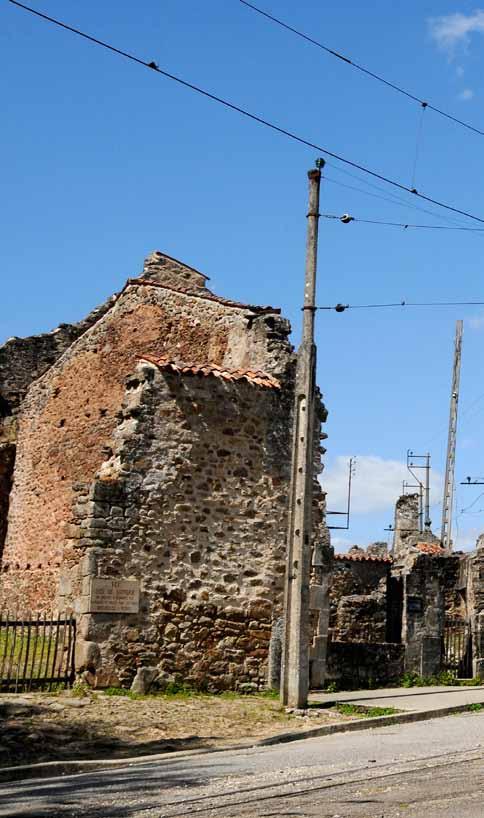
15 minute read
How War Monuments Keep His tory Lessons Alive
ultureC
How War Monuments Keep History Lessons Alive
by Jacqueline Cutler
“Prisoners of History: What Monuments to World II Tell Us About our History and Ourselves” by Keith Lowe; William Collins A pedestal is a risky place to take a stand. In America, official tributes to leaders from Robert E. Lee to Abraham Lincoln have been destroyed or defaced. In Europe, memorials to Communist dictators have been torn down. Keith Lowe’s “Prisoners of History: What Monuments to World II Tell Us About our History and Ourselves” examines how different countries’ statues and museums about the war resonate today. It’s a study in how memorials and memories don’t always match. What time proves is that while statues never change, what’s considered heroic does. And this varies from country to country. America’s view of World War II, naturally, differs from other nations. When the war changed on Dec. ,7 1941, with the bombing of the USS Arizona, it was our military not our civilians who were attacked. That experience shows in our statues. “America makes monuments to its heroes,” Lowe writes. “Europe much more often makes monuments to its victims. American monuments are triumphant; European ones are melancholy. American monuments are idealistic, while European ones – occasionally, at least – are more likely to be morally ambiguous.” Fittingly, America’s most famous World War II monument – the Arlington, Va. statue commemorating the flag-raising on Iwo Jima – isn’t named after the war. The Marine Corps Memorial isn’t about a battle, but the people who fought it and those who came before them. It puts all their pride and sacrifice into a simple symbol: The Stars and Stripes. Other nations’ monuments are more complicated. The most important World War II site in London is the Bomber Command Memorial, dedicated to the pilots who brought the war to Germany. It’s also the most controversial, like the missions it commemorates. Although the Royal Air Force initially limited its raids to military targets, it later bombed civilian populations, vowing to destroy “what is left of German morale.” Although he once praised the RAF,
Cover of the book «Prisoners of History: What Monuments to World II Tell us About our History and Ourselves» by Keith Lowe after the firebombing of Dresden incinerated 25,000 people, Winston Churchill raged against its “acts of terror and wanton destruction.” The about-face left some feeling betrayed. “Most people were very pleased with Bomber Command during the war and until it was virtually won,” the Command’s official historian later dryly noted. “Then they turned around and said it wasn’t a very nice way to wage war.” Promoted by Britain’s right-wing newspapers, funded by private donations, the Bomber Command Memorial predictably emerged at its 2012 unveiling as not just a military symbol, but a political one. Its columned design was Victorian, recalling Britain’s lost days of empire. Its figures were white and their posture resigned. It not only saluted a war that was won but mourned a past that was gone. And its statues seemed to know it. “They are a group of heroes who appear to have nothing heroic to do,” Lowe writes. “They merely stand there, gazing across London’s Green Park, waiting stoically to see what new disappointments might be looming on the horizon.” The more complicated the country’s role in World War II, the more conflicted its memorials can grow. Initially, Italy’s government stood with Hitler. Once the Allies landed, though, chaos reigned, with an anti-fascist government taking over in the South and dictator Benito Mussolini moving his pro-Nazi regime to the North. Today, the country’s memories are similarly split. In Bologna, the Shrine to the Fallen salutes the resistance’s left-wing martyrs, with portraits of some 2,000 murdered heroes lining a medieval plaza. In tiny Predappio, Mussolini’s birthplace, rightwing pilgrims regularly trek to his family’s crypt, approaching the unofficial memorial waving fascist banners and sporting black shirts in honor of his brutal militia. “This place is our Bethlehem,” one supporter explained. Some government memorials are outright propaganda, like the Monument to Brotherhood in Arms, erected in Warsaw in 1945. Designed by a Russian officer, it floridly announced “Glory to the heroes of the Soviet Army,” praising those “who gave their lives for the freedom and independence of the Polish Nation.” There was no mention of the Soviet Union’s invasion
ultureC
of Poland, of course. Or its massacre of Polish officers in 1940. Or its decades-long denial of that nation’s true independence. The pro-USSR statue was finally taken down in 2011. It is slated to eventually be displayed in a museum, with other dusty artifacts. Perhaps because the Soviet Union wanted to forget its early, friendly relationship with the Nazis, its memorials were particularly good at rewriting history and emphasizing its later suffering. In modern Russia’s Volgograd – Stalingrad, during the war – there are dozens of monuments to the nation and its dead. The largest statue, a depiction of Mother Russia waving a sword, is nearly twice the size of the Statue of Liberty. Unveiled in 1967, she not only paid tribute to the country’s stoic sacrifice but announced its birth as a world leader. Today, in a shrunken nation, her defiance seems less convincing. “We used to be a superpower,” as one Russian later explained. “Now we’re Bangladesh with missiles.” Far more impressive than Russia’s massive memorials are the silent, haunting remains of a town. On June 1944 ,10, a unit of the brutal Waffen-SS invaded the tiny town of Oradour-sur-Glane. The officer in charge accused the residents of hiding guns. When no one confessed, he demanded the mayor select hostages from among the townspeople. The mayor refused, offering himself and his sons instead. Enraged, the SS officer ordered his men to round up the entire village. The Nazis quickly machine-gunned 642 men, women, and children. Their homes, schools, and church were set on fire. Then the Germans marched out. Only five young men, hiding under a mound of corpses, survived to escape and tell the tale. The ruins have not been touched since. A literal ghost town, it stands in mute witness to war’s horror. It’s painful proof that sometimes the most affecting memorials are the simplest. In downtown Seoul, South Korea, there’s an unassuming bronze monument known as the Peace Statue. It depicts a young girl sitting on a bench, a small bird perching on her shoulder. The girl stares straight ahead, fists clenched in her lap. The statue is unremarkable, but the context, and its placement, is devastating. The Peace Statue is dedicated to the comfort women, the tens of

Ruins of the martyred village Oradour-surGlane (Limousin region in west-central France) /Getty

thousands of Korean females who were forced into military brothels, as sex slaves for the Japanese army. And what this statue is staring at, so intently, so unforgivingly, is the Japanese Embassy across the street. The provocation is deliberate, and many would say, necessary. Although Germany has confronted its war crimes, Japan avoids the subject. Its history books downplay or deny the nation’s atrocities. Japan’s significant memorials either salute its own victims in Hiroshima and Nagasaki or, at Tokyo’s Yasukuni Shrine, honor its military – war criminals included. Japan chooses to remember only some of its past. But memory is one of the things that memorials, even detested ones, serve. That is something Lowe hopes modern iconoclasts remember. “Tearing monuments down does not solve our history,” he writes. “It simply drives that history underground. While a movement still stands, it will always need to be confronted, discussed. In this way, our monuments hold us to account.”
This article was originally published in New York Daily News.
Po rt ra it

Nancy Pelosi: The Most Powerful Female Politician in US History
Majalla – London
Nancy Pelosi is the 52nd Speaker of the House of Representatives, having made history in 2007 when she was elected the first woman to serve as Speaker of the House. On January 3, the California Democratic Representative was elected to another term — her fourth — one she has promised will be her last. The congresswoman plans to set aside by 2023, spelling the end of a 20-year reign as the topranking Democrat in the chamber. Pelosi was born Nancy D’Alesandro on March 26, 1940, in Baltimore, Maryland. She carries on the family tradition of being involved in politics. Her father served in Congress and was the mayor of Baltimore for 12 years, and her brother Thomas later served as mayor of Baltimore as well. As a young girl, she managed her father’s book of people who owed him political favours. Pelosi graduated from Trinity College in Washington, D.C., in 1962. While a student there, she met Paul Pelosi. She was a mother of five by 1969, when the family moved to San Francisco. Paul worked as a banker, while Nancy raised their children and started a Democratic Party club at her home. Focused on raising her family, Pelosi got into politics slowly, starting out as a volunteer for the Democratic Party. She rose up the party ranks and by 1976, she worked for the presidential campaign of California Gov. Jerry Brown. In 1981, she became the Democratic Party chair for the state of California. At age 47, after her youngest child had left for college, Pelosi was encouraged by a dying congresswoman to run for her seat. She threw 100 house parties, recruited 4,000 volunteers, and raised $1 million in seven weeks. She narrowly won a special election and was reelected in 1988 to a full term. Pelosi easily won subsequent elections in her overwhelmingly Democratic district. Pelosi got a big promotion in 2001, when she was named the House Democratic whip, the No. 2 job in the party. After raising $1.8 million for Democrats through her leadership PAC in 2002, she got the top job when Dick Gephardt stepped down as minority leader. She was the first woman to ever lead a party in Congress. After the Democrats won majorities in both the House and the Senate in the 2006 midterm elections, Pelosi was chosen to become the first woman to take the post of speaker of the House. In the first 100 hours of being speaker in 2006, Pelosi raised the minimum wage, enacted the 9/11 commission report, ended many tax subsidies to oil companies, and made new rules about lobbying. She was sometimes a divisive figure. A vocal critic of President George W. Bush’s stance on the war in Iraq, she advocated for the withdrawal of troops from the region. Pelosi found herself at the center of a controversy in 2009 when the CIA asserted that she had been made aware of its use of waterboarding of terrorism suspects—a technique that Pelosi had vocally opposed. Pelosi denied the CIA’s claims.
After Barack Obama won the presidency in 2008, Democrats controlled Congress and the White House for the first time in 14 years and Pelosi was in a position to work with a president of the same party. Pelosi remained House speaker until November 2010, when Republicans gained control of the House and elected John Boehner to the role, relegating Pelosi to minority leader. Despite her diminished role, Pelosi was still a major power player in DC, having spent a decade as the top House Democrat. Pelosi once again became House minority leader and remained a close ally to Obama during his second term. But after Democrats reclaimed control of the House in the 2018 midterms, Pelosi was once again elected House speaker at the beginning of 2019. Pelosi has clashed with former President Donald Trump in the last few years. She was on the front line in the battle with Donald Trump over his demand for $5.7 billion for a wall spanning the U.S.Mexico border. The stalemate turned into a contentious 35-day government shutdown, After months of resisting calls from progressives to initiate impeachment proceedings against Trump, in September 2019, Pelosi announced that the House would launch a formal impeachment inquiry. The investigation concluded in early December 2019, and several weeks later the House voted to impeach the president. Her frayed relationship with Trump was on display during his televised State of the Union address on February 4, with the president seemingly snubbing her attempted handshake and the speaker ripping up a copy of his speech afterward. The following day, the impeachment saga came to an end when the Senate voted along party lines to acquit Trump on both charges.

ealthH
Tai Chi or Yoga? 4 Important Differences

Here s How to Determine Which is Best for Your Needs ‘
Harvard Health
Tai chi and yoga have many similarities. Both are gentle, low-intensity exercises that have been practiced for hundreds of years. Both are good for your mind and body (see «Tai chi and yoga benefits»). And both have been shown to be beneficial for older adults in particular. How do you choose one over the other? Several differences can influence your choice. TAI CHI AND YOGA BENEFITS
Tai chi and yoga share a long list of health and wellness benefits. Both can improve your balance, flexibility, strength, mobility, mood, quality of life, range of motion, reflexes, and thinking skills. They also reduce pain and your risk of falls. How do two exercises accomplish all that? «Rather than targeting just one aspect of health -- like an aspirin for a headache -- yoga and tai chi movements address many

health systems and work synergistically,» says Peter Wayne, faculty editor of the Harvard Special Health Report An Introduction to Tai Chi.
1-FLOWING VS. STATIC MOVEMENTS
Tai chi and yoga use different types of movements to challenge your muscles and balance. Tai chi is like a graceful dance of flowing motions. As you perform a series of slow, choreographed movements, you breathe deeply, focus on body sensations, and gradually shift your weight from one pose to another. Yoga is a series of focused, mostly static (still) strengthening and stretching postures combined with breathing techniques.
2-STANDING VS. SITTING
Both tai chi and yoga can be adapted for people who want or need to sit in a chair while exercising. But generally speaking, tai chi is performed while standing. Yoga can involve standing, lying down, sitting on the floor, and kneeling on all fours. Some positions require you to bend, reach backward, or even turn upside down. These are important considerations if you don›t have access to a chair-based program and you either can›t stand for long periods or have difficulty getting up and down off the floor
3-A LOT TO REMEBER
Tai chi and yoga both have an instructor who leads you through the exercises. Still, some people have trouble following or memorizing tai chi choreography.
The good news: «Many modern tai chi programs have been simplified to include only a small number of movements that can be done in an easy-to-learn, repetitive manner,» explains Peter Wayne, faculty editor of the Harvard Special Health Report An
Introduction to Tai Chi and director of the Osher Center for Integrative
Medicine at Harvard-affiliated Brigham and Women›s Hospital.
4-STAND-OUT DIFFERENCES
While tai chi and yoga have similar benefits, each has a particular effect that stands out in scientific studies. «Tai chi improves your balance, and that leads to a %20 to %60 reduction in falls. The exercise sharpens all of the skills you need to stay upright -- leg strength, flexibility, range of motion, reflexes, and awareness of bodily sensations and mental focus,» Wayne says. Yoga appears to reduce pain -- especially back, neck, and other musculoskeletal pain. This could be from the gradual stretching and strengthening of muscles that support the back (such as the paraspinal muscles that help you bend your spine and the multifidus muscles that stabilize your vertebrae). Yoga also may reduce pain by reducing mental stress: stress tends to increase the perception of pain.
OTHER CONSIDERATIONS
Choosing between yoga and tai chi often comes down to personal preference and practical considerations. «Try them and see what you like,» Wayne suggests. «You might enjoy flowing movement more than being still.» You can always let your abilities guide you. If you have memory challenges, you might want to try yoga first; if you have severe arthritis, tai chi might be an easier option than yoga. But both types of exercises can be adapted for your ability, even if you have Parkinson›s disease or other physically limiting conditions. And that makes the instructor an important consideration. «You want a teacher who will adapt protocols to ensure that they›re safe and the appropriate level of challenge for you,» Wayne says. «If you have a health condition, it can help to have an instructor who also has medical training, such as a nurse or physical therapist.»



















